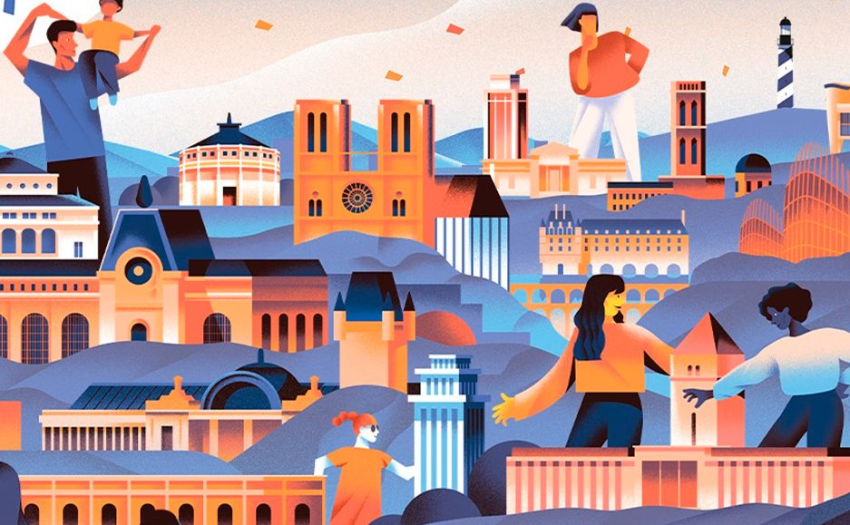
European Heritage Days 2025: "Windows on the past, doors to the future".
This year, the European Heritage Days are refocusing on their fundamentals: heritage! Architectural heritage" is the 2025 theme of this year's event, which takes place from September 19 to 21, in over 17,000 historic and heritage sites in France and throughout Europe. Let's set off on a tour of France and Europe to discover architectural wonders and emblematic sites, and open "windows to the past, doors to the future"!
Organized since 1984, the aim of the European Heritage Days is to showcase the extraordinary wealth of France's heritage to the widest possible audience, through a wide range of original events, unusual tours and exceptional openings. For this 42nd edition, the European Heritage Days have chosen to highlight "architectural heritage in all its richness and diversity". Last year, over 6.5 million visits were organized to thousands of heritage sites across France.
Architecture is everywhere
The European Heritage Days are organized in France by the Ministry of Culture and implemented at local level by the regional cultural affairs departments. Also under the patronage of the Council of Europe and the European Commission, they are supported by public and private owners of historic monuments.
After all, "architecture is everywhere". The dictionary of the Académie Française tells us that architecture is "the art of constructing, arranging and decorating buildings". Architecture is as much about "centuries-old cathedrals" as it is about " contemporary museums, traditional farmhouses" or "modernist railway stations". Architecture, continues the Ministry, "tells the story of the evolution of our societies, shaping our landscapes, towns and villages". To celebrate and explore this theme, "is also to seek to understand our way of inhabiting the world, past and present".
Discovering emblematic French architecture
To "understand and live", why not take to the roads of France to discover some emblematic and typical regional architecture, suggested by the event's organizers? These include
- Provençal bastides, which appeared in the late 17th century around towns in the south-east. These large mansions were "secondary residences for the wealthier classes". Bastides are often rectangular buildings with round-tiled roofs, built of local stone and covered with ochre-colored rendering. Many bastides are now privately owned, but some can be visited, such as Bastide Neuve in Allauch, the vacation home of writer Marcel Pagnol;
- the mining towns of Nord-Pas-de-Calais began to emerge in the 19th century. The oldest of these is the "coron", with its small, adjoining brick houses stretching for hundreds of meters. Although all these houses appear identical, in reality there is great architectural diversity. Today, this variety is a heritage asset: in 2012, many of these towns were inscribed on Unesco's World Heritage List;
- the half-timbered houses of Alsace, typical of the region, all have the same characteristics: timber-frame construction, infill between the empty spaces of the half-timbered beams (brick, rubble, cob or plaster) and sloping roofs with flat clay tiles. To admire them, visit the villages of Eguisheim or Riquewhir, or the Petite Venise district in Colmar;
- the Bresse farmhouses of Burgundy-Franche-Comté bear witness to a rich agricultural past. Their three-building structure - dwelling, barn and stable - has remained unchanged since the Middle Ages. These low, elongated farmhouses are carefully oriented to reduce exposure to the elements. Some of these farms are listed as Monuments Historiques, including, in the Ain department, the Ferme de la Forêt in Courtes and the Ferme du Colombier in Vernoux.
In the secret of places of power
In Paris, the architecture is much more classical and official! So-called "buildings of power" are given pride of place and are open to the public (often with registration):
- at the Assemblée nationale, where visitors can tour the hemicycle and the recently restored library, with its majestic ceilings painted by Delacroix, and enter the salons of the Hôtel de Lassay, home to the President of the Assemblée nationale;
- the Senate, where visitors can tour the Palais du Luxembourg, the Hôtel de la Présidence, the Salons de Boffrand and the greenhouses of the Jardin du Luxembourg. At the Palais du Luxembourg, the tour takes in the hemicycle, the heart of the assembly, the library, with its ceilings also painted by Delacroix, and the Salle des Conférences, the former throne gallery.
- At the Elysée Palace, which opens its doors as it does every year, visitors can discover the office of the President of the Republic, the Salle des Fêtes where receptions and state dinners are held, the Cour d'Honneur where the President welcomes his foreign counterparts, and the park;
- Hôtel Matignon, where the Prime Minister resides. Built in the early 18th century, in the heart of the Faubourg Saint-Germain, the Hôtel de Matignon has been the official workplace of the Head of Government since 1935. In addition to its magnificent reception rooms, it boasts the capital's largest private garden, and an exceptional plant heritage.
- the Hôtel de Ville de Paris, where visitors can discover the office of the Mayor of Paris, the Hôtel de Ville library, the Council Chamber and the ceremonial lounges.
Thousands of events to celebrate European diversity
After this short tour of France's regions and capital, why not take a look further afield in Europe?
As early as 1984, many European countries expressed an interest in organizing events similar to the French Heritage Days. Later, in 1991, the Council of Europe formalized the European Heritage Days, with which the European Union is associated, since it shares, among its objectives, "the promotion of diversity and dialogue around heritage, in all its forms, through three main axes: conservation/restoration, protection and enhancement of the whole of the common European heritage".
The event has now spread to nearly fifty countries and attracts between 20 and 30 million visitors a year across the European continent. For Europe, the official European Heritage Days website lists events in all participating countries. The dedicated site lists over 2,300 events in some 50 countries and regions, all celebrating the diversity of European architecture. So many "windows on the past" that are "doors on the future", as the official website so nicely puts it.






No comment
Log in to post comment. Log in.